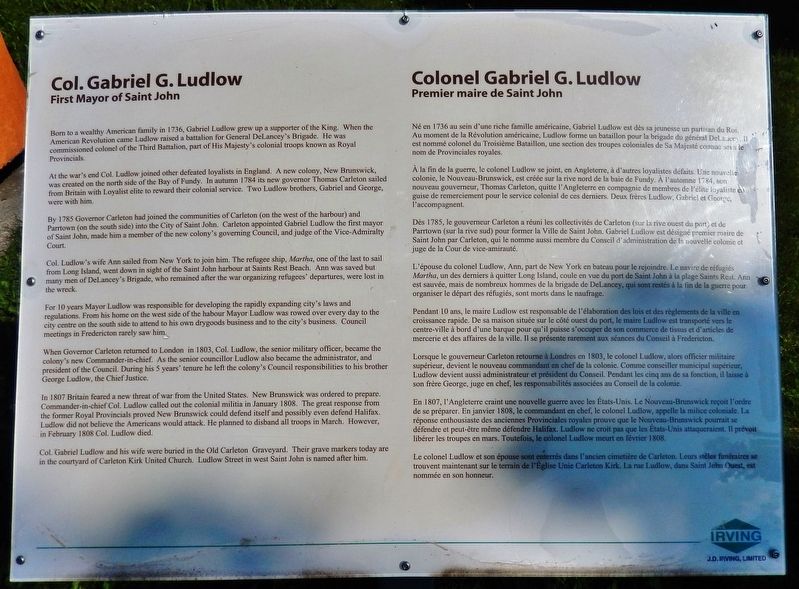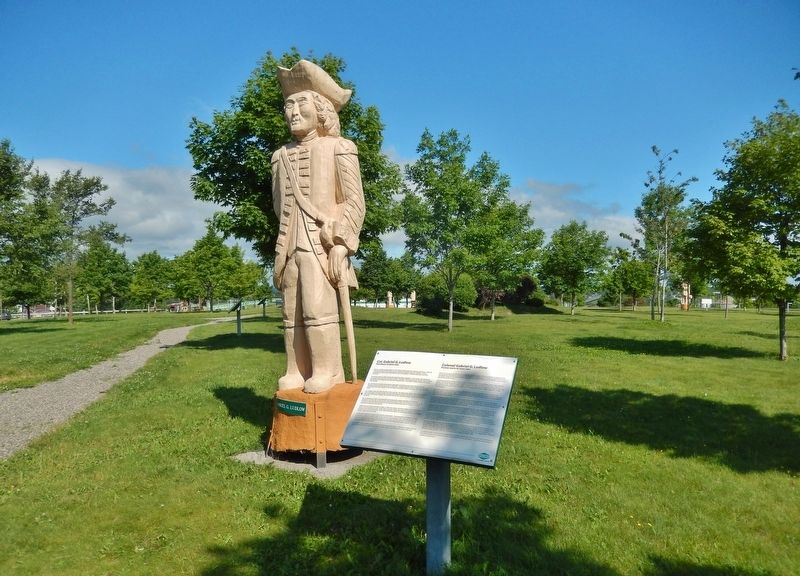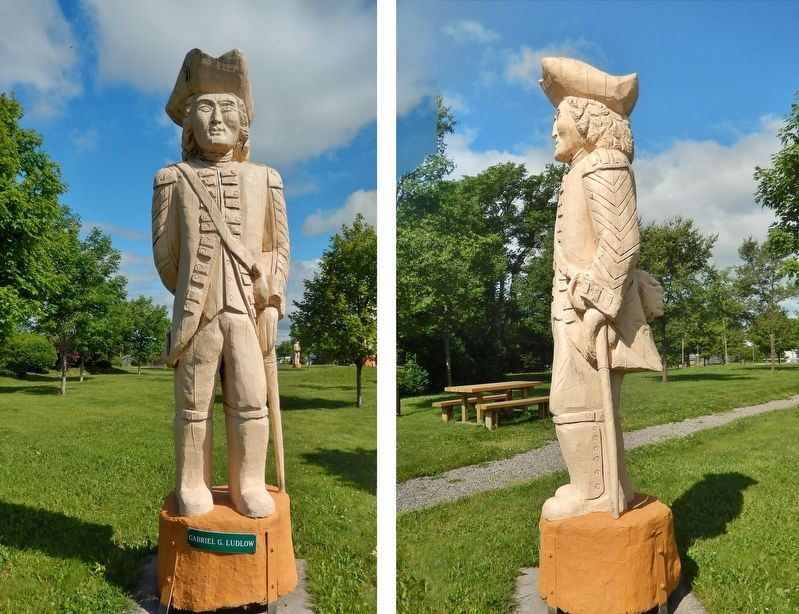Saint John in Saint John County, New Brunswick — The Atlantic Provinces (North America)
Colonel Gabriel G. Ludlow
First Mayor of Saint John | Premier maire de Saint John
Born to a wealthy American family in 1736, Gabriel Ludlow grew up a supporter of the King. When the American Revolution came Ludlow raised a battalion for General DeLancey's Brigade. He was commissioned colonel of the Third Battalion, part of His Majesty's colonial troops known as Royal Provincials.
At the war's end Col. Ludlow joined other defeated loyalists in England. A new colony, New Brunswick, was created on the north side of the Bay of Fundy. In autumn 1784 its new governor Thomas Carleton sailed from Britain with Loyalist elite to reward their colonial service. Two Ludlow brothers, Gabriel and George, were with him.
By 1785 Governor Carleton had joined the communities of Carleton (on the west of the harbour) and Parrtown (on the south side) into the City of Saint John. Carleton appointed Gabriel Ludlow the first mayor of Saint John, made him a member of the new colony's governing Council, and judge of the Vice-Admiralty Court.
Col. Ludlow's wife Ann sailed from New York to join him. The refugee ship, Martha, one of the last to sail from Long Island, went down in sight of the Saint John harbour at Saints Rest Beach. Ann was saved but many men of DeLancey's Brigade, who remained after the war organizing refugees' departures, were lost in the wreck.
For 10 years Mayor Ludlow was responsible for developing the rapidly expanding city's laws and regulations. From his home on the west side of the harbour Mayor Ludlow was rowed over every day to the city centre on the south side to attend to his own drygoods business and to the city's business. Council meetings in Fredericton rarely saw him.
When Governor Carleton returned to London in 1803, Col. Ludlow, the senior military officer, became the colony's new Commander-in-chief. As the senior councilor Ludlow also became the administrator, and president of the Council. During his 5 years' tenure he left the colony's Council responsibilities to his brother George Ludlow, the Chief Justice.
In 1807 Britain feared a new threat of war from the United States. New Brunswick was ordered to prepare. Commander-in-chief Col. Ludlow called out the colonial militia in January 1808. The great response from the former Royal Provincials proved New Brunswick could defend itself and possibly even defend Halifax. Ludlow did not believe the Americans would attack. He planned to disband all troops in March. However, in February 1808 Col. Ludlow died.
Col. Gabriel Ludlow and his wife were buried in the Old Carleton Graveyard. Their grave markers today are in the courtyard of Carleton Kirk United Church. Ludlow Street in west Saint John is named after him.
Né en 1736 au sein d'une riche famille américaine, Gabriel Ludlow est dès sa jeunesse un partisan du Roi. Au moment de la Révolution américaine, Ludlow forme un bataillon pour la brigade du général DeLancey. Il est nommé colonel du Troisième Bataillon, une section des troupes coloniales de Sa Majesté connue sous le nom de Provinciales royales.
À la fin de la guerre, le colonel Ludlow se joint, en Angleterre, à d'autres loyalistes défaits. Une nouvelle colonie, le Nouveau-Brunswick, est créée sur la rive nord de la baie de Fundy. À l'automne 1784, son nouveau gouverneur, Thomas Carleton, quitte l'Angleterre en compagnie de membres de l'élite loyaliste en guise de remerciement pour le service colonial de ces derniers. Deux frères Ludlow, Gabriel et George, l'accompagnent.
Dès 1785, le gouverneur Carleton a réuni les collectivités de Carleton (sur la rive ouest du port) et de Parrtown (sur la rive sud) pour former la Ville de Saint John. Gabriel Ludlow est désigné premier maire Saint John par Carleton, qui le nomme aussi membre du Conseil d'administration de la nouvelle colonie et juge de la Cour de vice-amirauté.
L'épouse du colonel Ludlow, Ann, part de New York en bateau pour le rejoindre. Le navre de réfugiés Martha, un des derniers à quitter Long Island, coule en vue du port de Saint John à la plage Saints Rest. Ann est sauvée, mais de nombreux hommes de la brigade de DeLancey, qui sont restés à la fin de la guerre pour organiser le départ des réfugiés, sont morts dans le naufrage.
Pendant 10 ans, le maire Ludlow est responsable de l'élaboration des lois et des règlements de la ville en croissance rapide. De sa maison située sur le côté ouest du port, le maire Ludlow est transporté vers le centre-ville à bord d'une barque pour qu'il puisse s'occuper de son commerce de tissus et d'articles de mercerie et des affaires de la ville. Il se présente rarement aux séances du Conseil à Fredericton.
Lorsque le gouverneur Carleton retourne à Londres en 1803, le colonel Ludlow, alors officier milita' supérieur, devient le nouveau commandant en chef de la colonie. Comme conseiller municipal supérieur, Ludlow devient aussi administrateur et président du Conseil. Pendant les cinq ans de sa fonction, il laisse à son frère George, juge en chef, les responsabilités associées au Conseil de la colonie.
En 1807, l'Angleterre craint une nouvelle guerre avec les États-Unis. Le Nouveau-Brunswick reçoit l'ordre de se préparer. En janvier 1808, le commandant en chef, le colonel Ludlow, appelle la milice coloniale. La réponse enthousiaste des anciennes Provinciales royales prouve que le Nouveau-Brunswick pourrait se défendre et peut-être même défendre Halifax. Ludlow ne croit pas que les États-Unis attaqueraient. Il prévoit libérer les troupes en mars. Toutefois, le colonel Ludlow meurt en février 1808.
Le colonel Ludlow et son épouse sont enterrés dans l'ancien cimetière de Carleton. Leurs stèles funéraires se trouvent maintenant sur le terrain de l'Église Unie Carleton Kirk. La rue Ludlow, dans Saint John Ouest, est nommée en son honneur.
Erected by J.D. Irving, Limited.
Topics. This historical marker is listed in these topic lists: Government & Politics • Settlements & Settlers • War, US Revolutionary • Waterways & Vessels. A significant historical year for this entry is 1736.
Location. 45° 15.393′ N, 66° 5.405′ W. Marker is in Saint John, New Brunswick, in Saint John County. Marker can be reached from Lancaster Avenue, 0.2 kilometers east of Bridge Road (New Brunswick Route 100), on the left when traveling east. Marker is located along the walking path in Wolastoq Park, near the south end of the park. Touch for map. Marker is at or near this postal address: 211 Lancaster Avenue, Saint John NB E2M 2K8, Canada. Touch for directions.
Other nearby markers. At least 8 other markers are within walking distance of this marker. Benedict Arnold (a few steps from this marker); John Robertson (within shouting distance of this marker); K.C. Irving (within shouting distance of this marker); Simonds, Hazen and White (within shouting distance of this marker); Rebels Attack (within shouting distance of this marker); Sir Samuel Leonard Tilley (within shouting distance of this marker); William Kilby Reynolds (within shouting distance of this marker); Robert Foulis (within shouting distance of this marker). Touch for a list and map of all markers in Saint John.
Related markers. Click here for a list of markers that are related to this marker. Wolastoq Park
Also see . . . Gabriel George Ludlow. At the end of the revolution Gabriel followed his brother to England, where they joined other loyalists in seeking preferment and compensation for their losses. Throughout 1783 and 1784 the group mounted a strong lobby, the major result of which was the creation of a new colony, New Brunswick, on the north shore of the Bay of Fundy to accommodate loyal refugees and their families. (Submitted on November 2, 2019, by Cosmos Mariner of Cape Canaveral, Florida.)
Credits. This page was last revised on November 3, 2022. It was originally submitted on October 31, 2019, by Cosmos Mariner of Cape Canaveral, Florida. This page has been viewed 421 times since then and 38 times this year. Photos: 1, 2, 3. submitted on November 2, 2019, by Cosmos Mariner of Cape Canaveral, Florida.


